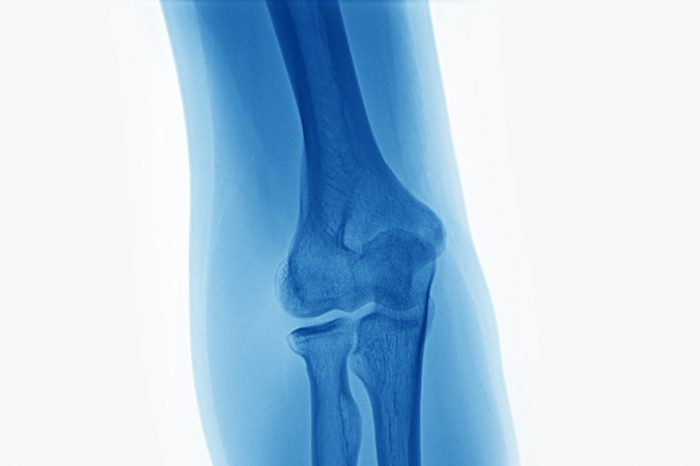
The ulnar nerve is one of the three main nerves in the arm, and can become entrapped at several places along the course. The most common place of injury is at the elbow, and is called cubital tunnel syndrome or ulnar neuropathy at the elbow (UNE). Entrapment of the ulnar nerve at the elbow is the second most common entrapment neuropathy in the arm (Mondelli et al 2005; Caliandro et al 2012).
The ulnar nerve travels from the shoulder girdle down the arm, and runs along the inside of the elbow through the cubital tunnel. This is a bony canal deep to the medial epicondyle (the bony bump along the inside of the elbow). The nerve then travels between muscles in the forearm and into the hand providing sensation to the little finger and half of the ring finger. The nerve helps control fine movements in the hand.
Common symptoms include numbness and tingling in the hand and fingers. This can give the sensation that the little finger and half of the ring fingers are falling asleep. Injury can also cause aching on the inside of the elbow and weakening of the grip with difficulty with finger coordination.
In most cases, symptoms can be managed without surgery. A change in activities or bracing can often help resolve symptoms. Common recommendations include:
Ultrasound guided peripheral nerve hydrodissection has been shown to be a less invasive alternative to surgery, and has been shown to help with pain and improve nerve function on objective EMG testing.
If nonsurgical methods do not work or if the compression is causing muscle weakness or damage in your hand sometimes surgery is recommended. Surgery has varying rates of success, relapse and complications.
Ultrasound guided peripheral nerve hydrodissection has been shown to be a less invasive alternative to surgery, and has been shown to help with pain and improve nerve function on objective EMG testing.
Nerve hydodissection is a technique to treat painful nerves that are entrapped in scar tissue from surgery/trauma or damaged from chronic repetitive movements. This technique involves using ultrasound to find the nerve and guide a needle around the nerve and introducing fluid to mechanically push scar tissue ways from the nerve, and create separation between the nerve and adhesions or scar tissue. The procedure is not painful and takes minutes to complete. Hydrodissection has been used to treat a variety of peripheral nerve entrapment syndromes and is a relatively new and emerging concept.
Case reports and a small pilot study have demonstrated decreased pain, decreased ulnar nerve cross-sectional area and improved electrodiagnostic measurements with ultrasound guided injections around the nerve (Kim et al, 2012; Choi et al, 2015; Stoddard et al, 2019).
The procedure is thought to be safe and carries minimal risk. The 3 reports in the literature showed no long-term negative complications from the procedure.
In larger series of peripheral nerve blocks there were no sustained complications. The primary fear associated with peripheral nerve hydrodissection has been that of intraneural injections and nerve damage. A study of 257 patients receiving peripheral nerve blocks before shoulder surgery 17% of patients had intraneural injection with no patients experiencing neurologic complications (Malavazzie & Nery, 2011). Another study of 72 cases of intraneural injections, none resulted in any permanent nerve injury (Liu et al., 2011).
There is anesthetic in the solution used to hydrodissect the nerve, and this can give the sensation of numbness or weakness for a few hours after the procedure. Usually, no pain medication is needed after the procedure. Patients may notice improvement within a few days, but sometimes it can take up to a month after the procedure to see benefit. The procedure can be repreated if there is only a partial relief of pain or if symptoms recur.
Nerve hydrodissection, or percutaneous neuroplasty, is safe and versatile technique that can be used on any peripheral nerve. This procedure can often prevent surgery or the need for medications. To learn more about whether you would be a candidate for ultrasound guided percutaneous hydrodissection contact us at BSBortho.com.
The procedure requires a very high level of skill in musculoskeletal ultrasound and ultrasound guided injections.
Adductor longus selective tenotomy is a modern surgical treatment for chronic groin pain that offers faster recovery and better outcomes than traditional full release surgery. The adductor longus, an inner thigh
Read MoreDiscover how ultrasound helps diagnose plantar fat pad atrophy, a leading cause of ball-of-foot pain. Learn about symptoms, thickness cutoffs, and why early detection matters for relief.
Read More